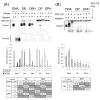Gene delivery through the use of a hyaluronate-associated intracellularly degradable crosslinked polyethyleneimine
- PMID: 19631979
- PMCID: PMC2764302
- DOI: 10.1016/j.biomaterials.2009.07.012
Gene delivery through the use of a hyaluronate-associated intracellularly degradable crosslinked polyethyleneimine
Abstract
For a non-viral gene delivery system to be clinically effective, it should be non-toxic, compatible with biological components, and highly efficient in gene transfection. With this goal in mind, we investigated the gene delivery efficiency of a ternary complex consisting of DNA, an intracellularly degradable polycation, and sodium hyaluronate (DPH complex). Here, we report that the DPH ternary complex achieved significantly higher transfection efficiency than other polymer systems, especially in the presence of serum. The high transfection efficiency and serum tolerance of DPH are attributed to a unique interplay between CLPEI and HA, which leads to (i) the improved stability of DNA in the extracellular environment and at the early stage of intracellular trafficking and (ii) timely dissociation of the DNA-polymer complex. This study reinforces findings of earlier studies that emphasized each step as a bottleneck for efficient gene delivery; yet, it is the first to show that it is possible to overcome these obstacles simultaneously by taking advantage of two distinctive approaches.
Figures




Similar articles
-
Polyethyleneimine/DNA polyplexes with reduction-sensitive hyaluronic acid derivatives shielding for targeted gene delivery.Biomaterials. 2013 Jan;34(4):1235-45. doi: 10.1016/j.biomaterials.2012.09.049. Epub 2012 Nov 3. Biomaterials. 2013. PMID: 23127334
-
Ternary complexes with core-shell bilayer for double level targeted gene delivery: in vitro and in vivo evaluation.Pharm Res. 2013 May;30(5):1215-27. doi: 10.1007/s11095-012-0960-9. Epub 2012 Dec 27. Pharm Res. 2013. PMID: 23269504
-
Analysis of the surface structure of DNA/polycation/hyaluronic acid ternary complex by Raman microscopy.J Pharm Biomed Anal. 2010 Jan 5;51(1):268-72. doi: 10.1016/j.jpba.2009.07.024. Epub 2009 Jul 25. J Pharm Biomed Anal. 2010. PMID: 19692196
-
Efficient gene delivery using chitosan-polyethylenimine hybrid systems.Biomed Mater. 2008 Jun;3(2):025013. doi: 10.1088/1748-6041/3/2/025013. Epub 2008 May 14. Biomed Mater. 2008. PMID: 18477817 Review.
-
Degradable polyethylenimines as DNA and small interfering RNA carriers.Expert Opin Drug Deliv. 2009 Aug;6(8):827-34. doi: 10.1517/17425240903029183. Expert Opin Drug Deliv. 2009. PMID: 19558333 Review.
Cited by
-
Polyethyleneimine-Based Drug Delivery Systems for Cancer Theranostics.J Funct Biomater. 2022 Dec 23;14(1):12. doi: 10.3390/jfb14010012. J Funct Biomater. 2022. PMID: 36662059 Free PMC article. Review.
-
A DNA prime-protein boost vaccination strategy targeting turkey coronavirus spike protein fragment containing neutralizing epitope against infectious challenge.Vet Immunol Immunopathol. 2013 Apr 15;152(3-4):359-69. doi: 10.1016/j.vetimm.2013.01.009. Epub 2013 Feb 1. Vet Immunol Immunopathol. 2013. PMID: 23428360 Free PMC article.
-
In-vitro and in-vivo difference in gene delivery by lithocholic acid-polyethyleneimine conjugate.Biomaterials. 2019 Oct;217:119296. doi: 10.1016/j.biomaterials.2019.119296. Epub 2019 Jun 21. Biomaterials. 2019. PMID: 31254934 Free PMC article.
-
Programmed Cell Death Protein Ligand-1 Silencing with Polyethylenimine-Dermatan Sulfate Complex for Dual Inhibition of Melanoma Growth.ACS Nano. 2017 Oct 24;11(10):10135-10146. doi: 10.1021/acsnano.7b04717. Epub 2017 Oct 12. ACS Nano. 2017. PMID: 28985469 Free PMC article.
-
Expression of PEI-coated gold nanoparticles carrying exogenous gene in periwinkle mesophyll cells and its practice in huanglongbing research.iScience. 2022 May 29;25(6):104479. doi: 10.1016/j.isci.2022.104479. eCollection 2022 Jun 17. iScience. 2022. PMID: 35712078 Free PMC article.
References
-
- Edelstein ML, Abedi MR, Wixon J. Gene therapy clinical trials worldwide to 2007 - an update. J Gene Med. 2007;9:833–842. - PubMed
-
- Stephenson J. Studies Illuminate Cause of Fatal Reaction in Gene-Therapy Trial. JAMA. 2001;285:2570. - PubMed
-
- Bonetta L. Leukemia case triggers tighter gene-therapy controls. Nat Med. 2002;8:1189–1189. - PubMed
-
- Marshall E. CLINICAL RESEARCH: Gene Therapy a Suspect in Leukemia-like Disease. Science. 2002;298:34–35. - PubMed
-
- Jeong JH, Kim SW, Park TG. Molecular design of functional polymers for gene therapy. Progress in Polymer Science. 2007;32:1239–1274.
Publication types
MeSH terms
Substances
Grants and funding
LinkOut - more resources
Full Text Sources
Other Literature Sources
Medical

